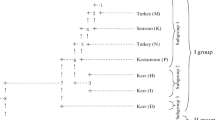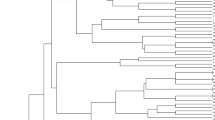Abstract
Emmer wheat (Triticum dicoccon Schrank) is still largely cultivated in India, and highly appreciated for the preparation of traditional dishes. Moreover, its nutritional characteristics could justify a development of its cultivation. The perspective of genetic improvement however requires a good knowledge of the genetic diversity existing within the eco-geographic group of Indian emmer wheats. A set of 48 emmer wheat accessions from India including 28 from a local collection and 20 Indian accessions obtained from CIMMYT, Mexico, was assessed for genetic variability using 47 microsatellite (SSR) markers, distributed over all the 14 chromosomes. The number of alleles per locus ranged from 2 to 9, with an average of 3.87 alleles per locus. A total of 201 alleles were detected at 52 loci with average polymorphic information content of 0.35 per locus and a mean resolving power of 1. The pair-wise similarity coefficients calculated from binary data matrix based on presence or absence of alleles varied from 0.15 to 0.98, but was greater than 0.5 for most accessions, indicating a high level of similarity. A cluster analysis based on the similarity matrix identified nine distinct accessions and three clusters. All the recently developed commercial varieties were distinctly different from the clusters. Based on the analysis, it appears that Indian emmer wheats are not very diverse. Consequently, there is a need to increase the diversity within the Indian emmer wheat eco-geographic group, by introducing diversity from other eco-geographic groups, or even from other wheat species.

Similar content being viewed by others
References
Anderson JA, Churchill GA, Autrique JE, Tanksley SD, Sorrells ME (1993) Optimizing parental selection for genetic linkage maps. Genome 36:181–186
Annapurna K (2000) Comparative study on protein and storage quality of supplemented uppuma of dicoccum and durum wheat. MSc thesis, University of Agricultural Sciences, Dharwad, India
Barcaccia G, Molinari L, Porfiri O, Veronesi F (2002) Molecular characterization of emmer (Triticum dicoccon Schrank) Italian landraces. Genet Resour Crop Evol 49:415–426
De Vita P, Riefolo C, Codianni P, Cattivelli L, Fares C (2006) Agronomic and qualitative traits of T. turgidum ssp. dicoccum genotypes cultivated in Italy. Euphytica 150:195–205
Dice LR (1945) Measures of the amount of ecologic association between species. Ecology 26:297–302
Dorofeev VF, Udachin RA, Semenova LV, Novikova MV, Grazhdaninova OD, Shitova IP, Merezhko AF, Filatenko AA (1987) World wheat. Agropromizdat, Leningrad, p 560 (in Russian)
Elouafi I, Nachit MM (2004) A genetic linkage map of the Durum x Triticum dicoccoides L. backcross population based on SSRs and AFLP markers, and QTL analysis for milling traits. Theor Appl Genet 108:401–413
Fernandez ME, Figueras AM, Benito C (2002) The use of ISSR and RAPD markers for detecting DNA polymorphism, genotype identification and genetic diversity among barley cultivars with known origin. Theor Appl Genet 104:845–851
Figliuolo G, Perrino P (2004) Genetic diversity and intra-specific phylogeny of Triticum turgidum L. subsp. dicoccon (Schrank) Thell. revealed by RFLPs and SSRs. Genet Resour Crop Evol 51:519–527
Gadaleta A, Mangini G, Mule G, Blanco A (2007) Characterization of dinucleotide and trinucleotide EST-derived microsatellites in the wheat genome. Euphytica 153:73–85
Hanchinal RR, Yenagi NB, Bhuvaneswari G, Math KK (2005) Grain quality and value addition of emmer wheat. University of Agricultural Sciences, Dharwad
Khanjari SA, Hammer K, Buerkert A, Roder MS (2007) Molecular diversity of Omani wheat revealed by microsatellites: I. Tetraploid landraces. Genet Resour Crop Evol 54:1291–1300
Luo MC, Young ZL, Kawahara T, You F, Waines JG, Dvorak J (2007) The structure of wild and domesticated emmer wheat populations, gene flow between them, and the site of emmer domestication. Theor Appl Genet 114:947–959
Mangini G, Taranto F, Giove SL, Gadaleta A, Blanco A (2010) Identification of durum wheat cultivars by a minimum number of microsatellite markers. Cereal Res Commun 38:155–162
Mani BR (2004) Further evidence on Kashmir Neolithic in the light of recent excavations at Kanishkapura. JISHA 1:137–143
Mithal SK, Kopper MN (1990) Evaluation and conservation of wheat genetic resources in India. In: Srivastava JP, Damania AB (eds) Wheat genetic resources: meeting diverse needs. Wiley, Chichester, pp 201–209
Nagarajan S (2004) Opportunities and strategies to make Indian wheat globally competitive. In: Rao VS, Singh G, Misra SC (eds) Wheat for warmer areas. Anamaya Publishers, New Delhi, pp 11–23
Nayeem KA, Sivasamy M, Nagarajan S (2006) Induced Pusa dwarfing genes in T. turgidum var. dicoccum and their inheritance. Plant Mutation Reports 1:17–20
Nesbitt M, Samuel D (1996) From staple crop to extinction? The archaeology and history of the hulled wheat. In: Padulosi S, Hammer K, Heller J (eds) Hulled wheats, promoting the conservation and use of underutilized and neglected crops. IPGRI, Rome, pp 40–99
Oak MD, Tamhankar SA, Rao VS, Bhosale SB (2002) Polymorphism of gluten proteins in Indian Dicoccum wheat (Triticum turgidum ssp. dicoccum) revealed by SDS and Acid-PAGE. J Genet Breed 56:245–250
Oak MD, Tamhankar SA, Rao VS, Misra SC (2011) Milling and pasta making potential of cultivated dicoccum wheat (Triticum turgidum ssp. dicoccum). Cereal Res Commun 49:426–435
Pagnotta MA, Mondini L, Atallah MF (2005) Morphological and molecular characterization of Italian emmer wheat accessions. Euphytica 146:29–37
Pagnotta MA, Mondini L, Codianni P, Fares C (2009) Agronomical quality, and molecular characterization of twenty Italian emmer wheat (Triticum dicoccon) accessions. Genet Resour Crop Evol 56:299–310
Perrino P, Infantino S, Basso P, Di Marzio A, Volpe N, Laghetti G (1993) Valutazione e selezione di farro in ambienti marginali dell’Appennino molisano (II nota). Informatore Agrario 43:41–44 (in Italian)
Prevost A, Wilkinson MJ (1999) A new system of comparing PCR primers applied to ISSR fingerprinting of potato cultivars. Theor Appl Genet 98:107–112
Pujar S, Tamhankar SA, Rao VS, Gupta VS, Naik S, Ranjekar PK (1999) Arbitrarily primed-PCR based diversity assessment reflects hierarchical grouping of Indian tetraploid wheat genotypes. Theor Appl Genet 99:868–876
Pujar S, Tamhankar SA, Gupta VS, Rao VS, Ranjekar PK (2002) Diversity analysis of Indian tetraploid wheat using inter-simple sequence repeat markers reveals their superiority over random amplified polymorphic DNA markers. Biochem Genet 40:63–69
Rogers SO, Bendich AJ (1988) Extraction of DNA from milligram amounts of fresh, herbarium and mummified plant tissues. Plant Mol Biol 5:69–76
Rohlf FJ (2000) NTSYS-pc: 2.1 numerical taxonomy and multivariate analysis system. Exeter Software, New York
Shewry PR (2009) Wheat. J Exp Bot 60:1537–1553
Tatikonda L, Wani SP, Kannan S, Beerelli N, Sreedevi TK, Hoisington DA, Devi P, Varshney RK (2009) AFLP-based molecular characterization of an elite germplasm collection of Jatropha curcas L., a biofuel plant. Plant Sci 176:505–513
Teklu Y, Hammer K, Huang XQ, Roder MS (2006) Analysis of microsatellite diversity in Ethiopian tetraploid wheat landraces. Genet Resour Crop Evol 53:1115–1126
Teklu Y, Hammer K, Roder MS (2007) Simple sequence repeats marker polymorphism in emmer wheat (Triticum dicoccon Schrank): Analysis of genetic diversity and differentiation. Genet Resour Crop Evol 54:543–554
Varshney RK, Chabane K, Hendre PS, Aggarwal RK, Graner A (2007) Comparative assessment of EST-SSR, EST-SNP and AFLP markers for evaluation of genetic diversity and conservation of genetic resources using wild, cultivated and elite barleys. Crop Sci 173:638–649
Vavilov NI (1964) Mirovye resursy sortov khlebnykh zlakov, zernovykh bobovykh, l’na i ikh ispolzovanie v selektzii (world resources of cereals, leguminous seed crops and flax, and their utilization in breeding). Nauka press, Moskow and Leningrad (in Russian)
Weir BS (1996) Genetic data analysis II. Sinauer Publishers, Sunderland, Massachusetts
Yap I, Nelson RJ (1996) Winboot: a program for performing bootstrap analysis of binary data to determine the confidence limits of UPGMA-based dendrograms. IRRI Discussion paper series no. 14, International Rice Research Institute, Manila, Philippines
Zaharieva M, Ayana NG, Al Hakimi A, Misra SC, Monneveux P (2010) Cultivated emmer wheat (Triticum dicoccon Schrank), an old crop with promising future: a review. Genet Resour Crop Evol 57:937–962
Acknowledgments
This work was funded by the CGIAR Generation Challenge Programme (GCP).
Author information
Authors and Affiliations
Corresponding author
Rights and permissions
About this article
Cite this article
Salunkhe, A., Tamhankar, S., Tetali, S. et al. Molecular genetic diversity analysis in emmer wheat (Triticum dicoccon Schrank) from India. Genet Resour Crop Evol 60, 165–174 (2013). https://doi.org/10.1007/s10722-012-9823-9
Received:
Accepted:
Published:
Issue Date:
DOI: https://doi.org/10.1007/s10722-012-9823-9




